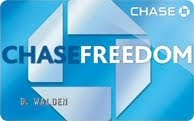 Summary
Summary: If you are looking for a no-hassle rewards card, look no further than
Chase Freedom. With its simple rewards platform and easy reward redemption process, earning and using your rewards has never been simpler.
Finding that perfect rewards card can be likened to finding a needle in a haystack. With so many options from so many different credit card companies, it is easy to become overwhelmed. If you are looking for a simple, easy-to-use rewards card look no further than the
Chase Freedom card. Chase has designed a simple rewards platform that makes it easy to earn and redeem your rewards. Coupled with no annual fee, unlimited rewards, and rewards that never expire, how can you go wrong?
The Nitty-GrittyWith the Chase Freedom card, you can enjoy a zero-percent APR (annual percentage rate) for the first six months your account is open. Your creditworthiness will determine your APR, which starts as low as 12.99%. The Freedom card also gives you the ability to transfer balances to your card at zero percent interest for the first twelve months your account is open, but it must be done when you initially apply for the card. Otherwise a minimum 12.99% rate applies for any balance transfer, again, depending on your credit history. You’ll want to stay on top of your payments; any account over 60 days past due reverts to the default 29.99% APR, potentially reducing any rewards you might accrue if you carry a balance. It should be noted that to even be considered for this credit card, you must have a good credit history. In addition, employment status and annual income are also important factors when determining your creditworthiness.
Chase BlueprintOnce you are approved for the Chase Freedom card, be sure to enroll in Chase Blueprint to begin managing your account. Blueprint allows you to take control of your finances, providing you with the necessary tools to pay down/pay off your account balance. This service is free to all Chase Freedom cardholders, and can be altered as needed to meet your needs. You can specify which purchases you’d like to pay in full to avoid interest charges as well as which purchases you’d like to pay for over time, called Split. You can split the payments up over however many months you’ll need, and Blueprint will track your progress on each statement until it is paid off. Their Finish It tool shows you how long it will take to pay off a large balance, showing you the amount in interest you will save as well as how many fewer payments you’ll have to make.
RewardsAt the core of the rewards program, you earn a full 1% cash back on every purchase with no earnings cap. Chase has also taken a leaf from Discover’s page and added rotating rewards and a shopping portal to earn additional rewards on purchases. The rotating rewards program allows you to earn 5% back on purchases made in various categories that change every three months. Quarterly enrollment is required to ensure that your purchases are properly tracked, and earnings are capped at $600 per month. Using the Chase shopping portal allows the participating merchants to track your purchases and issue your rewards. Merchants like Bath & Body Works, Best Buy, Home Depot, iTunes, and Wal-Mart all allow you to earn percentages from each purchase ranging from 1% to as high as 20%. There are a few merchants that give you a preset dollar amount per purchase rather than a percentage, so be sure to check before you buy.
Rewards RedemptionRedeeming your hard-earned rewards is always the best part, and Chase offers several redemption options to choose from. You can opt to redeem your points for travel by booking online through Chase travel, which is powered by Orbitz. You can also redeem your rewards for gift cards from merchants like Best Buy, Dunkin Donuts, Lowes, or Target. Of course, you can also choose to receive the good ‘ole greenback to do whatever your heart desires. With the Chase Freedom card, the sky is the limit and the choice is yours.
Bottom LineThe
Chase Freedom card is an excellent rewards card for those who want either cash back or gift cards to their favorite stores. This card is easy-to-use, has a simple reward calculation formula, and has an easy rewards redemption process. However, in order to enjoy the benefits this card offers you must have a good credit rating. Chase Freedom also has higher interest rates than some of the other rewards cards out there which do not translate well for those who will carry a balance. If you are a frequent flier, you may want to find a card that allows you to amass airline miles coupled with the other frequent traveler perks other cards offer.
Labels: chase_credit_card, Chase_Freedom, credit_card_review
 Yesterday, the U.S. Treasury Department announced that it plans to sell all 7+ billion shares of Citigroup common stock during the rest of 2010. Here's a clip from the press release:
Yesterday, the U.S. Treasury Department announced that it plans to sell all 7+ billion shares of Citigroup common stock during the rest of 2010. Here's a clip from the press release:





